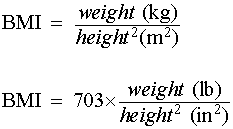Calculation of Body Mass Index (BMI)
Body mass index (BMI) is a statistical measure of the weight of a person scaled according to height.
Body mass index is defined as the individual's body weight divided by the square of his/her height. The formulas universally used in medicine produce a unit of measure of kg/m2. Body mass index may be accurately calculated using any of the formulas below.

A frequent use of the BMI is to assess how much an individual's body weight departs from what is normal or desirable for a person of his/her height. The weight excess or deficiency may, in part, be accounted for by body fat although other factors such as muscularity also affect BMI significantly.
Human bodies rank along the index from around 15 (near starvation) to over 40 (morbidly obese). This statistical spread is usually described in broad categories: underweight, normal weight, overweight, obese and morbidly obese.
| Category | BMI range - kg/m2 |
|---|---|
| Starvation | less than 16.5 |
| Underweight | 16.5 to 18.5 |
| Normal | 18.5 to 25 |
| Overweight | 25 to 30 |
| Obese | 30 to 35 |
| Clinically Obese | 35 to 40 |
| Morbidly Obese | greater than 40 |
A graph of body mass index is shown below. The dashed lines represent subdivisions within a major class. For instance the “Underweight” classification is further divided into “severe,” “moderate,” and “mild” subclasses.

BMI is used differently for children. It is calculated the same way as for adults, but then compared to typical values for other children of the same age. Instead of set thresholds for underweight and overweight, the BMI percentile allows comparison with children of the same sex and age.
A BMI that less than the 5th percentile is considered underweight and above the 95th percentile is considered overweight. Children with a BMI between the 85th and 95th percentile are considered to be at risk of becoming overweight.
Related Topics:


